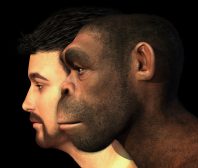Definition
noun, plural: catarrhines
Any of the primates belonging to the parvorder Catarrhini, characterized by having the nostrils close together (narrow-nosed) as opposed to another group of simians, platyrrhines, characterized by being flat-bridged nose
adjective
Of an animal having a characteristic similar to the animals of the pavorder Catarrhini, particularly being narrow-nosed or having nostrils that are close together; leptorrhine; catarrhinian
Supplement
Primates are placental mammals and taxonomically may be divided into two suborders: the Strepsirrhini and the Haplorhini. The Haplorhini includes the simians and the tarsiers. The tarsier line and the simian line diverged during the Cenozoic era, i.e. about 60 million years ago. The simians may further be subdivided into two major groups: catarrhines (Old World monkeys and apes) and platyrrhines (New World monkeys).
Catarrhines are simians belonging to the parvorder Catarrhini. They are characterized by having a narrow nose. Their nostrils are close together as opposed to platyrrhines that have a flat-bridged nose. Other distinctive features include having flat fingernails and toenails, eight instead of 12 premolars, and lacking prehensile tails.
Catarrhines include gibbons, orangutans, gorillas, chimpanzees, and humans. Two superfamilies that make up the parvorder Catarrhini are Cercopithecoidea (Old World monkeys) and Hominoidea (apes).
Word origin: Greek kata– (“down”) + rhin– (“nose”)
Scientific classification:
- Kingdom: Animalia
- Phylum: Chordata
- Class: Mammalia
- Order: Primates
- Suborder: Haplorhini
- Infraorder: Simiiformes
- Parvorder: Platyrrhini É. Geoffroy, 1812
See also:







